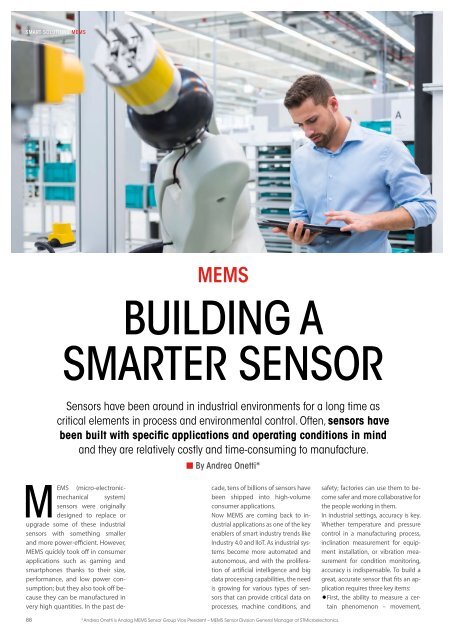Smart Industry 2/2018
Smart Industry 2/2018 - The IoT Business Magazine - powered by Avnet Silica
Smart Industry 2/2018 - The IoT Business Magazine - powered by Avnet Silica
You also want an ePaper? Increase the reach of your titles
YUMPU automatically turns print PDFs into web optimized ePapers that Google loves.
<strong>Smart</strong> Solutions MEMS<br />
MEMS<br />
Building a<br />
smarter sensor<br />
Sensors have been around in industrial environments for a long time as <br />
critical elements in process and environmental control. Often, sensors have<br />
been built with specific applications and operating conditions in mind <br />
and they are relatively costly and time-consuming to manufacture.<br />
n By Andrea Onetti*<br />
MEMS (micro-electronicmechanical<br />
system)<br />
sensors were originally<br />
designed to replace or<br />
upgrade some of these industrial<br />
sensors with something smaller<br />
and more power-efficient. However,<br />
MEMS quickly took off in consumer<br />
applications such as gaming and<br />
smartphones thanks to their size,<br />
performance, and low power consumption;<br />
but they also took off because<br />
they can be manufactured in<br />
very high quantities. In the past decade,<br />
tens of billions of sensors have<br />
been shipped into high-volume<br />
consumer applications.<br />
Now MEMS are coming back to industrial<br />
applications as one of the key<br />
enablers of smart industry trends like<br />
<strong>Industry</strong> 4.0 and IIoT. As industrial systems<br />
become more automated and<br />
autonomous, and with the proliferation<br />
of artificial intelligence and big<br />
data processing capabilities, the need<br />
is growing for various types of sensors<br />
that can provide critical data on<br />
processes, machine conditions, and<br />
safety; factories can use them to become<br />
safer and more collaborative for<br />
the people working in them.<br />
In industrial settings, accuracy is key.<br />
Whether temperature and pressure<br />
control in a manufacturing process,<br />
inclination measurement for equipment<br />
installation, or vibration measurement<br />
for condition monitoring,<br />
accuracy is indispensable. To build a<br />
great, accurate sensor that fits an application<br />
requires three key items:<br />
• First, the ability to measure a certain<br />
phenomenon – movement,<br />
88<br />
*Andrea Onetti is Analog MEMS Sensor Group Vice President – MEMS Sensor Division General Manager at STMicroelectronics.
















